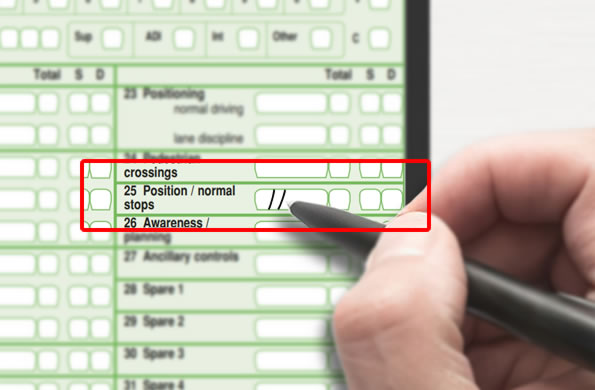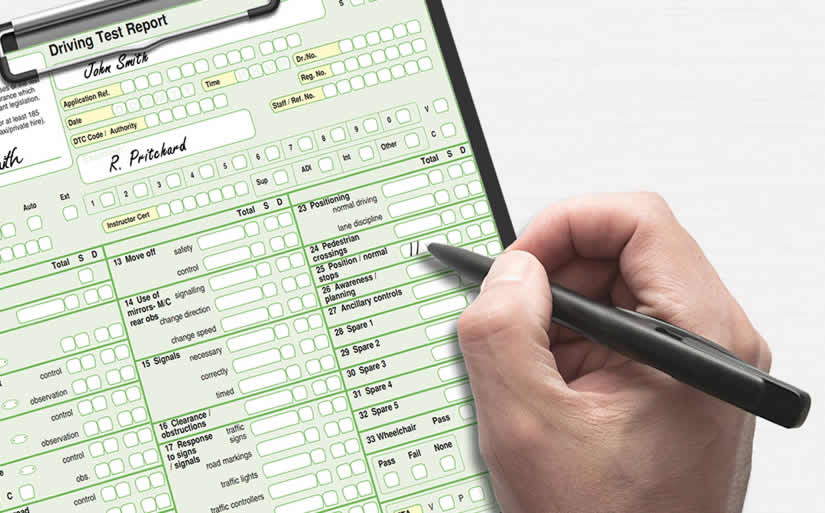We’ve covered many of the driving test faults when moving off, we’ll now take a look and common driving test faults when stopping on the left. During a driving test, your examiner will ask that you pull over and stop on the left of many occasions. This may be to carry out a manoeuvre such as parallel parking, or more often then not, to simply move off again.
What is Stopping on the Left?
During a driving test, stopping on the left requires that on the examiners instruction, you pull up and stop on the left side of the road, close and parallel, alongside the kerb.
Stopping on the Left and the Driving Test Report Sheet
On the driving test report sheet, stopping on the left represents category box number 25. In the long box, the examiner can mark minor faults, which can accumulate and be tallied up and the total amount being written the next box along. Within category box 25, you’ll also see additional boxes labelled ‘S’ and ‘D’. These are for serious or dangerous faults. If you gain just one serious or dangerous fault in any category throughout your test, you will fail.
You can make up to a total of 15 ‘minor’ faults throughout your test and still pass, however, if you receive many identical faults, all for the same category, you may still fail, even if you’ve not accumulated 15 minor faults.

Examples of Stopping on the Left During the Driving Test
During the practical driving test, the examiner will ask that you stop on the left side of the road on. Examiner may ask that you stop on the left many times throughout the 40 minute test. Examples of why the examiner may ask that you stop on the left include:
- Stop on the left and move off on a level surface
- Stop on the left to move off on a hill (hill start)
- Stop on the left to move off at an angle (move off from behind a parked car)
- Stop on the left to carry out the parallel parking manoeuvre
What is the Examiner Checking When Stopping on the Left?
The two main areas that the examiner is assessing you on are safety for vehicle occupants, other road users and pedestrians, and control of the vehicle. To correctly carry out these two key areas, the examiner is looking that you:
- Use the MSM (Mirror, Signal, Manoeuvre) routine correctly
- Choose a safe, convenient and legal place (SCALP) to stop
- Use the car’s controls appropriately and use the brake progressively to slow down
- Stopping close to the kerb without hitting it
- Secure the car when stationary
- Cancel a signal, if applied
Common Driving Test Faults When Stopping on the Left
When we’ve passed the driving test, pulling up at the side of the road, usually on the left is something we do frequently when parking. During the test, examiners need to check that we can do this safely and under full control. With that in mind, let’s look at the common driving test faults that occur when stopping on the left. If you know what the most common faults are, hopefully you can avoid them whilst on your driving test.
Use the MSM Routine Correctly
MSM stands for mirrors, signal manoeuvre and is a common driving routine taught by all driving instructors. It’s a simple routine and when used for stopping on the left, you simply check your internal mirror followed by the left passenger side mirror, signal to the left and then carry out the manoeuvre by pulling over to the left and stopping.
However, the reason why driving test faults occur is not because the routine isn’t carried out correctly, but because the test candidate doesn’t act appropriately with what they see in their mirrors. Let’s explain; the examiner will either ask that you stop on the left in a specific place, this could be behind a car (move off at an angle) or to carry out a hill start. In this instance, the examiner will typically assess the situation to ensure that it’s safe to stop where they have instructed you to.
More frequently however, they’ll ask that you stop on the left, when ready and to find a safe and convenient place to stop. Where the faults occur is that the test candidate carries out the MSM routine, pulls over to the left and stops far too quickly and without consideration for drivers that are following. This can cause following drivers to brake abruptly or swerve round you.
The key here is to check your mirrors and signal, but give the driver behind you a longer amount of time to react. If a driver is following you, avoid abruptly slowing down and stopping, but allow them time to see your signal, then slow down gradually. They can then slow down safely or overtake you in safe to do so. For additional help, read the tutorial on learning how to stop on the left in an automatic car, using the MSM routine.
Choosing a Safe, Convenient and Legal Place to Stop
As mentioned above, the examiner may ask that you stop in a specific place. If that’s the case, stop where the examiner asks you to stop. If however they ask that you stop when ready and to find a safe and convenient place to stop, this means that you should find a safe, convenient and legal place (SCALP) to stop. When stopping, ensure that you choose somewhere that’s:
- Safe: Avoid stopping somewhere that may be considered unsafe such as on a bend or the brow of a hill as stopping in these areas are dangerous for overtaking vehicles.
- Legal: Avoid stopping at a bus stop, double yellow lines, zig zag lines or within 10 metres of a junction for instance.
- Convenient: Avoid stopping somewhere that’s inconvenient for other road users, such as directly opposite a vehicle that’s parked on the opposite side of the road, making it difficult for passing road users. Avoid stopping opposite a junction as this can make it difficult for drivers exiting the junction and avoid stopping across a driveway unless the examiner instructs you to stop there.
Choosing a suitable place to stop isn’t always easy, so avoid feeling panicked and take your time to ensure that you choose the right place to stop. Faults range from minors, up to serious or dangerous faults if parked illegally or in a dangerous location.
Use the Car’s Controls Appropriately, Use the Brake Progressively to Slow Down
When you’ve found a suitable place to stop, the examiner will be looking at your ability to control the car. If driving an automatic, you’ll not need to be concerned with clutch and gear changing, but you will need to ensure you use controls such as indicators, steering and brakes effectively.
Begin to slow down using progressive braking. This means use a combination of engine braking and gently applying the brake to come to a smooth stop. There are techniques to help with braking such as feel, firm and feather, see how to brake in an automatic car and how to brake smoothly in an automatic car for a guide.
Also avoid steering too abruptly towards the kerb. Turn the steering just a little so that you head towards the kerb at a shallow angle. This will help you to avoid hitting the kerb. The how to stop on the left in an automatic car tutorial explains how much steering to apply when moving towards the kerb.
Unless you’re very abrupt with the controls or get confused about which controls you should be using, it’s unlikely you’ll encounter any serious or dangerous faults here.
Stopping Close to the Kerb Without Hitting It
During the test, the examiners wants to see you pull up closely, alongside the kerb without hitting, but also to not be too far away from it. Roughly speaking, provided that you’re 30 cm or less away from the kerb, you’ll be fine.
If you scrape the kerb, provided not too harshly, you’ll likely not receive a fault at all. But heavy scrapes or hitting the kerb will see fault marks appearing on your driving test report sheet. If you go as far as mounting the actual pavement, that will be considered a serious or even dangerous fault.
Faults usually occur due to moving over to the left too quickly. After checking the mirrors and signalling to the left, slow the car down and move gradually over towards the kerb. Along with a slow speed, reference points often help with spatial awareness for test candidates to establish their distance from the kerb. To help with this, see how to park next to the kerb without hitting it.
Secure the Car When Stationary
Safety is of course essential, even when the car has stopped. When stopped, make the car safe by applying the parking brake and putting the gear lever into Park (P). On automatic cars, Park locks the transmission. You’ll not fail the driving test if you forget to do this, but if the car unintentionally moves because you didn’t secure it, then it becomes an issue.
Cancel a Signal, if Applied
You don’t have to signal to the left when stopping if nobody is around to see it. However, if you did apply a signal, make sure you cancel soon after you’ve stopped. Examiners really don’t like it when test candidates forget and leave their indicators on.
